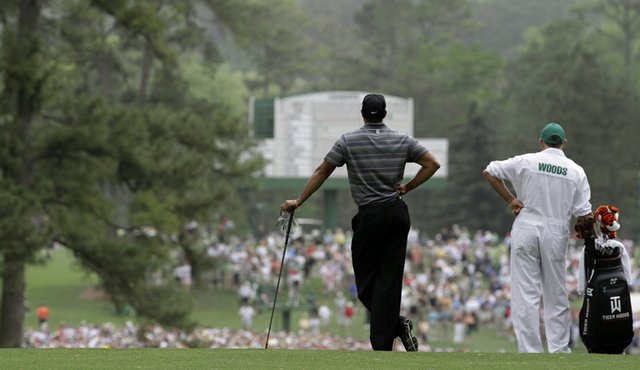When you come to think of it that is the secret of most of the great holes all over the world. They all have some kind of a twist. C.B. MACDONALD
“And frankly, all they do is market slow play.”
/In Gene Yasuda's look at the dire state of the golf industry, industry consultant Stuart Lindsay suggested that the PGA Tour deserves great blame for slow play.
Ben Crane's Team Whips Up A Viral Video To Help Their Man's Image
/Cink's Lunch Break Proves Slow Play Policy Is On Hold
/"A Plan To Help The Tour Raise 'Rabbits'"
/Line Develops At U.S. Amateur To Handle Slow Play Penalty Mediations!**
/"For the visitors who play golf in Hainan, it takes them seven hours to play a round of golf. That is a real shortage of supply."
/The WSJ's Emily Veach interviews Ken Chu of the Mission Hills Group about golf in China. And you thought play was slow in America...
WSJ: As many as 200,000 people attended the 2009 Omega Mission Hills World Cup. Analysts have said the number of golfers in China is about 300,000, other reports are as high as 3 million. What are your estimates and how can you turn those spectators into golfers?
Mr. Chu: There are close to 3 million golfers in China already, and that is increasing. Golf is perceived as a luxurious sport only because the demand is much greater than the supply, and it is still very young in the country. Every tournament we have hosted is free for the public to come and understand the game. Centuries ago, golf in Europe and also in the United States was considered a very prestigious, very expensive sport as well. Look what it has turned into today. It's very common overseas. In China, it's not today because there's only 24 years of history. The supply of golf is under the demand that's required. It will grow, definitely.
A normal round of golf takes about four hours. For the visitors who play golf in Hainan, it takes them seven hours to play a round of golf. That is a real shortage of supply. In the coming years, maybe around 50 courses will be built (in Hainan). We are building for the demand.
The Next Slow Play Side Effect?
/"Spieth’s star-is-born status is drawing massive attention and rejuvenating a tournament that was was lacking in star power."
/ Thank God for sponsor's exemptions, right boys? Isn't it great that a 16-year-old is upstaging you?
Thank God for sponsor's exemptions, right boys? Isn't it great that a 16-year-old is upstaging you?"Slow play is a legitimate issue, but not to the point where I think we need to do something like that."
/Another head-scratcher from Commissioner Tim Finchem, this time in John Feinstein's Golf World column on slow play:
Of course, it has been 18 years since a PGA Tour player received a stroke penalty for slow play -- and Finchem doesn't sound as though he wants to see it happen again anytime soon.
"Slow play is a legitimate issue," he said, "but not to the point where I think we need to do something like that. The real problem isn't how long it takes to play a round but when one player makes it uncomfortable for the other player or players because of his pace. That's just bad etiquette. And it's true, we do have some players who are in denial about being slow."
So is the Commissioner sending out word, or has sent out word that he does not want a stroke penalty assessed? We know he's not a fan of controversy, so it wouldn't be a stretch to think he's sent word that penalty shots are brand-averse.
Gary Van Sickle also tackled slow play this week for SI and did it in very entertaining fashion. Naturally, he picked the one week they actually played faster at The Players, but he still offers several insights into the problem and a glossary of slow play handbook.
Clockblocked - Forget Greenwich Mean Time. On the PGA Tour, Time Par (no relation to Old Man Par) is what matters. Time Par is the time it should take to play each hole, as determined by the rules crew after careful study. At the Players, for instance, Time Par was two hours, 14 minutes for the front nine and 2:15 for the back, plus five minutes to make the turn. Time Par for the entire round by a threesome was 4:34, 3:58 for a twosome.
The 40 Time - How cool would it be if golf, like basketball, had a shot clock? It would be handy too, because once a group has been alerted that it's on the clock, a player has 40 seconds to hit his shot once it's his turn. The first to play the tee shot on a par-3, a second shot on a par-4 or par-5, a third shot on a par-5 or a stroke near or on the green, gets an additional 20 seconds. If a player exceeds his allotted time, he receives a bad timing.
News Of The Weird: Slow Play Protest Edition
/ Thanks to reader Mel for this story on Japanese golfer Yuko Mitsuka banning herself from a total of 11 women's tournaments after being fined for storming off the course over a two-stroke penalty.
Thanks to reader Mel for this story on Japanese golfer Yuko Mitsuka banning herself from a total of 11 women's tournaments after being fined for storming off the course over a two-stroke penalty.
The 25-year-old downed clubs and quit midway through her first round at last week's World Ladies Championship in protest at being penalised for slow play. Mitsuka was fined a record ¥2m (£14,400) but voluntarily withdrew from eight domestic and three overseas events as a sign of contrition.
"This is the biggest fine in Japanese LPGA history and reflects the seriousness of what took place," said the tour's Hideaki Otani. "The player offered to withdraw from those tournaments and the tour accepted that as the right punishment."
"Tour should rethink its aversion to controversy"
/I have a column in this week's Golf World that I just know Tim Finchem will be making copies of and distributing to his VP's with a big Post-It note attached, with the words "Maybe if you read this backwards it makes sense, Coterminously Yours, Tim."
"We've settled down now to a glacier pace here on the 10th hole."
/Thanks to John Strege for documenting Gary McCord's comment on the last group's slow play Sunday at Harbour Town. I heard it and swore I must have been wishfully thinking that an announcer just called out the leaders of a PGA Tour event!
When Davis and Furyk appeared to be dawdling on the 10th green on Sunday, CBS' Gary McCord said, "We've settled down now to a glacier pace here on the 10th hole."
They were playing twosomes on Sunday at the Verizon Heritage and it still took more than four hours to complete play.
Do you think that just maybe the networks are tired of the slow play and extended finishes caused by slow play? Finally?
"The game needs sweeping change now."
/ Nice job by Alistair Tait to not get swept up in the excitement of the day to let the ridiculous pace of play go unnoticed. In our live chat the UK readers noted Peter Alliss' complaints about the pace, which ended up at 5 hours and 45 minutes for the Woods-Kuchar-Choi group.
Nice job by Alistair Tait to not get swept up in the excitement of the day to let the ridiculous pace of play go unnoticed. In our live chat the UK readers noted Peter Alliss' complaints about the pace, which ended up at 5 hours and 45 minutes for the Woods-Kuchar-Choi group.
These days the five-hour plus round is the norm. The way it’s going, the six-hour round will soon become commonplace.
Meanwhile the R&A and USGA sit in their ivory towers and do absolutely nothing. Exactly two years ago, at Royal Birkdale, R&A chief executive Peter Dawson said there was going to be a meeting during The Players Championship where the subject of slow play would be discussed by governing bodies and professional tours. He promised then that he wouldn’t slow play us on this one. Two years later and we’re still waiting for the powers that be to do something.(Are you reading this Peter?)
What's interesting about round one was the role of the golf course setup. Clearly Fred Ridley and the committee wanted to get the players around in the face of a bad weather forecast. The easier hole locations and forward tee placements worked in one sense: thirty players finished under par and we saw some of the most exciting golf in years. Yet the pace of play remained awful. And as Tait notes in his piece, there's only one solution: shot clocks and penalty strokes.











